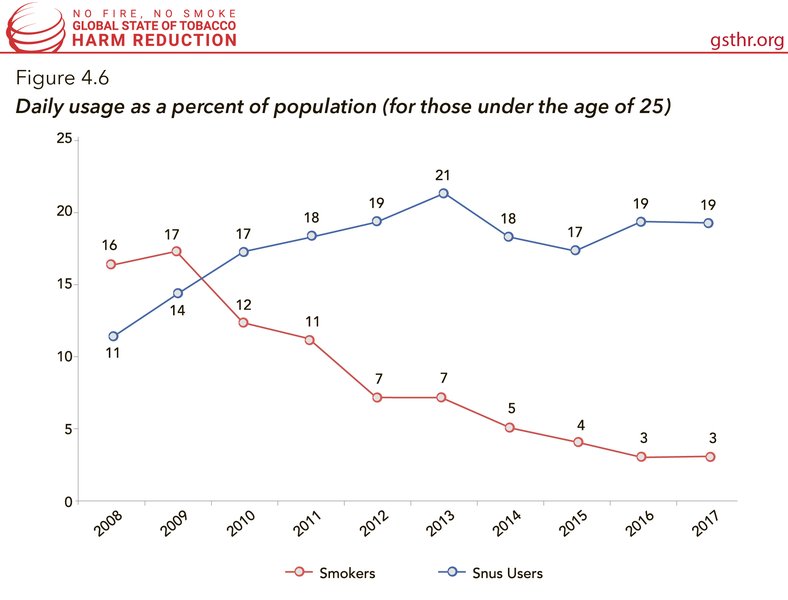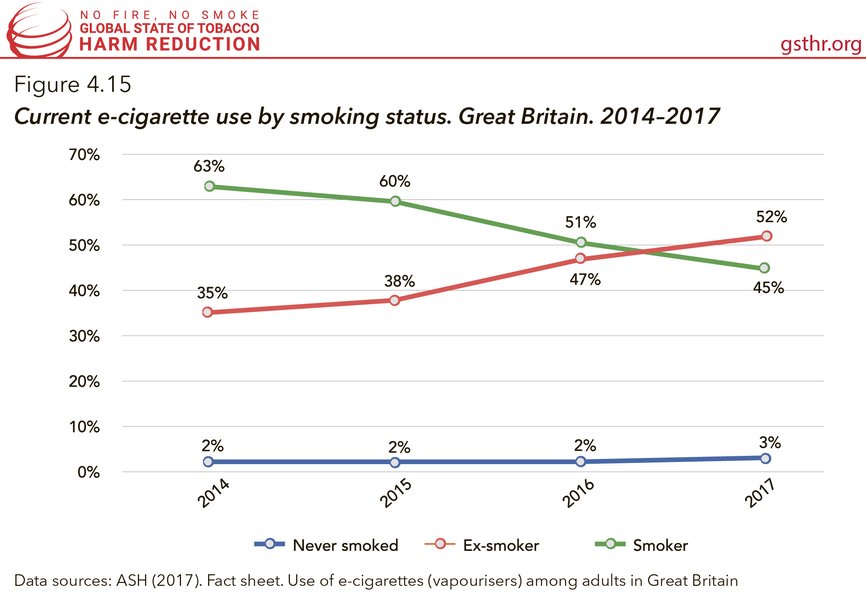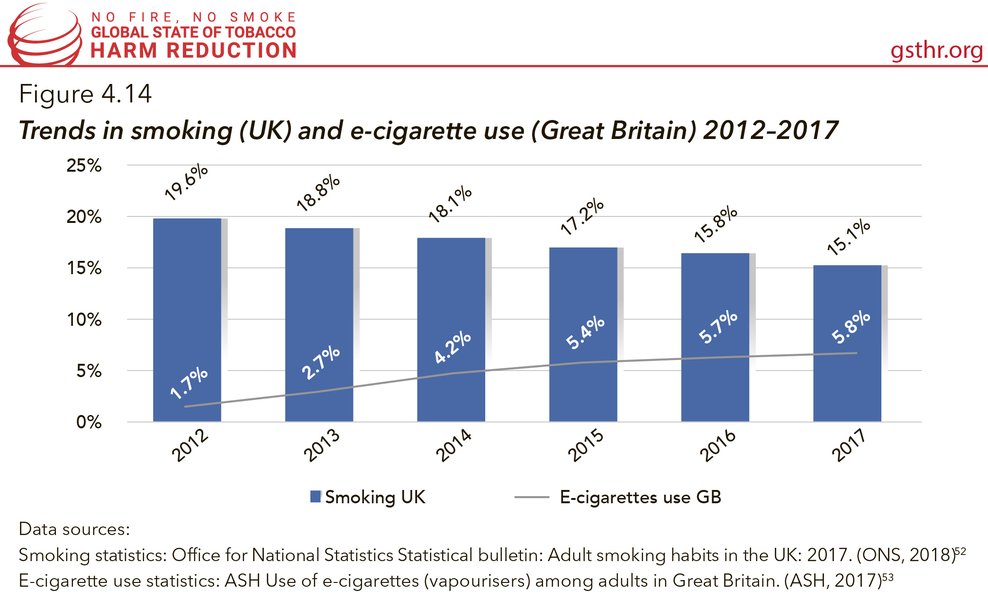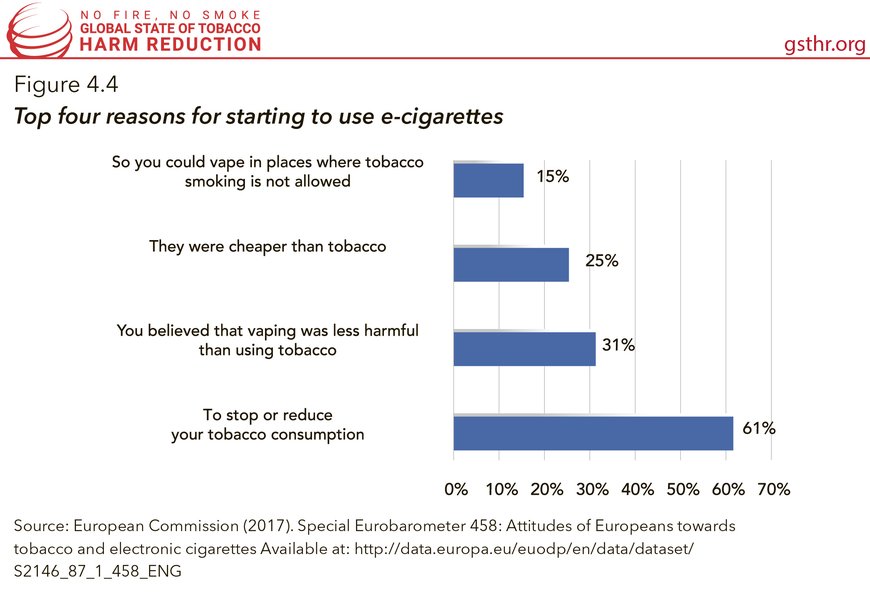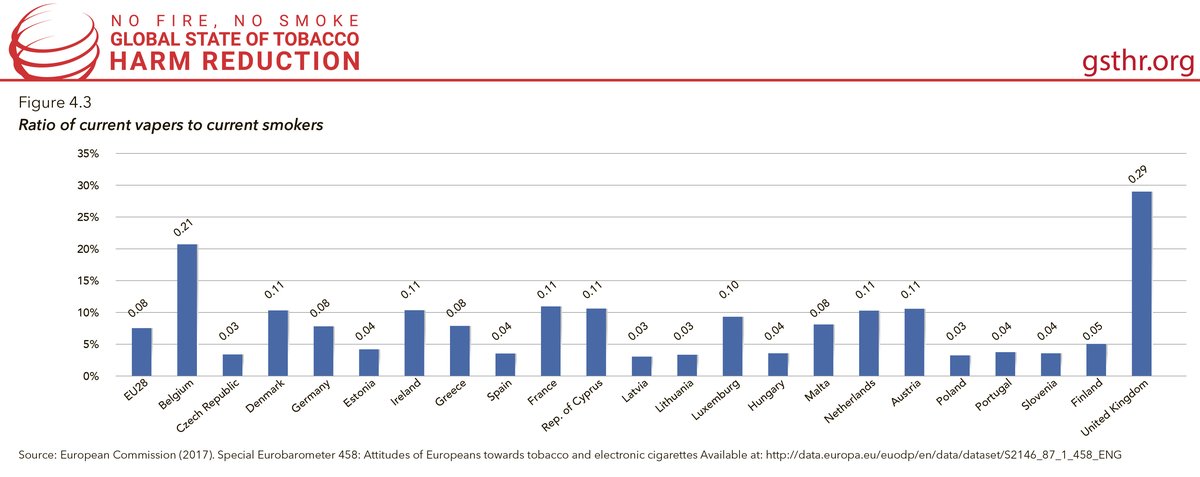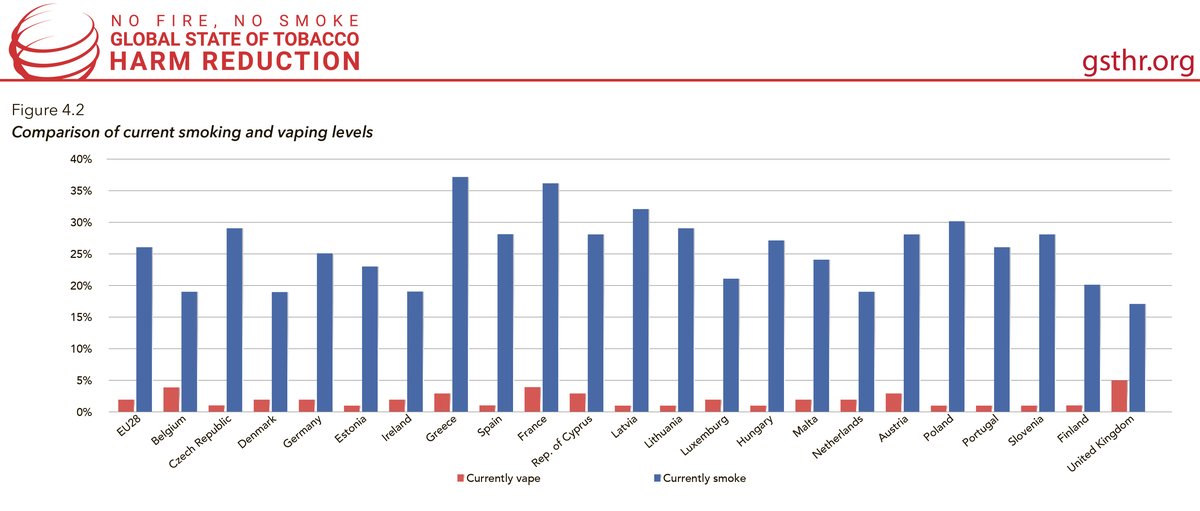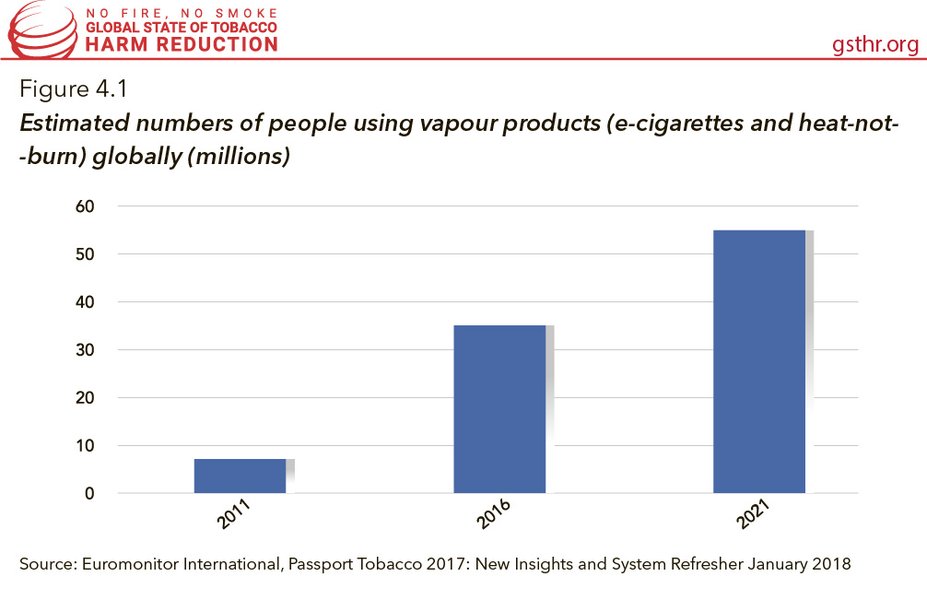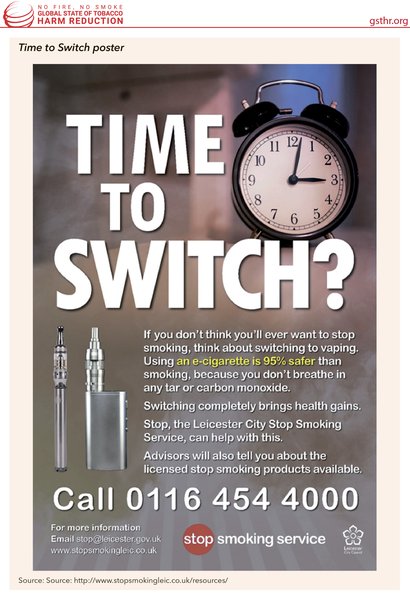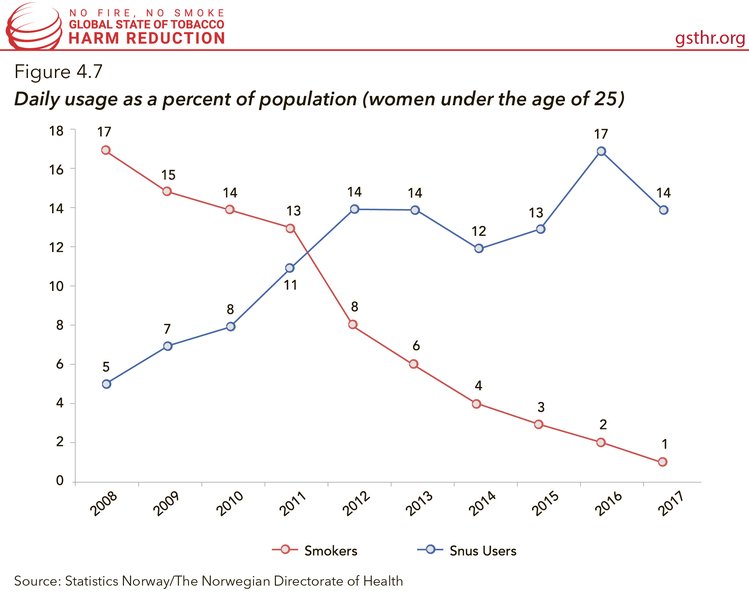Daily Usage as a Percent of Population (for Those Under the Age of 25)
- No Fire, No Smoke: The Global State of Tobacco Harm Reduction
This figure shows how the smoking rate amongst young people under the age of 25 in Norway has declined over the past decade, whilst snus use has simultaneously increased.
The overall percentage of people using nicotine via either snus or smoking has remained roughly the same over time – it is the choice of products that has changed over the last ten years. In 1997–99, about five percent of tobacco consumption was snus, and 95 percent was cigarettes. Overall tobacco consumption – by weight – declined by 40 percent between 1997 and 2017.
Several factors are responsible for the decline in smoking and rise in snus use in Norway:
» Snus is an exit from smoking for established smokers. Over time, the use of snus at the last quit attempt has risen from 10% in 2003 to around 23%, overtaking NRT by 2011. It is the most common way to quit smoking in Norway, after unassisted (cold turkey) quits.
» Snus use helps smokers to reduce smoking. Those who both smoke and use snus have a weekly cigarette consumption 37% below that of exclusive smokers. The proportion of dual users is small.
See also p. 46 of the report: No Fire, No Smoke: The Global State of Tobacco Harm Reduction 2018 — Global State of Tobacco Harm Reduction (gsthr.org)
Current E-Cigarette Use by Smoking Status, Great Britain, 2014-2017
- No Fire, No Smoke: The Global State of Tobacco Harm Reduction
Use of e-cigarettes is confined largely to current and ex-smokers and use amongst never smokers remains very low (at around two to three percent). Over time the proportion of current e-cigarette users who smoke tobacco has decreased and the proportion of ex-smokers has increased (and overtaken smokers).
The anti-smoking charity ASH has conducted repeat surveys on the use of e-cigarettes in the adult population in Great Britain (England, Wales, and Scotland) since 2012. Sample sizes are substantial at around 12,000 adults (18 and over) each year. This graph illustrates these data, and shows a steady increase in the proportion of the adult population who use e-cigarettes, up from just under two percent in 2012 to nearly six percent in 2017. There appears to be some slowing of the increase in 2016 and 2017. ASH, working with King’s College London, has estimated the prevalence of e-cigarette usage in Great Britain by using the findings of the surveys and applying these to the most recent population data available in each year.
These data show that in 2017:
» An estimated 2.9 million adults in Great Britain currently used e-cigarettes;
» Of the 2.9 million current e-cigarette users, approximately 1.5 million (52%) were ex-smokers.
See also p. 52 of the report: No Fire, No Smoke: The Global State of Tobacco Harm Reduction 2018 — Global State of Tobacco Harm Reduction (gsthr.org)
Trends in Smoking (UK) and E-Cigarette Use (Great Britain) 2012-2017
- No Fire, No Smoke: The Global State of Tobacco Harm Reduction
This figure shows the trend in e-cigarette use in GB against the trend in smoking in the UK. The trends are rather similar to those seen in Norway and Sweden where snus gradually replaced smoking – bearing in mind that the process in both countries was over a longer period of time.
The anti-smoking charity ASH has conducted repeat surveys on the use of e-cigarettes in the adult population in Great Britain (England, Wales, and Scotland) since 2012. Sample sizes are substantial at around 12,000 adults (18 and over) each year. These surveys show a steady increase in the proportion of the adult population who use e-cigarettes, up from just under two percent in 2012 to nearly six percent in 2017. There appears to be some slowing of the increase in 2016 and 2017. ASH, working with King’s College London, has estimated the prevalence of e-cigarette usage in Great Britain by using the findings of the surveys and applying these to the most recent population data available in each year. This shows that in 2017:
» An estimated 2.9 million adults in Great Britain were currently using e-cigarettes;
» Of the 2.9 million current e-cigarette users, approximately 1.5 million (52%) were ex-smokers
See also p. 52 of the report: No Fire, No Smoke: The Global State of Tobacco Harm Reduction 2018 — Global State of Tobacco Harm Reduction (gsthr.org)
Top Four Reasons for Starting to Use E-Cigarettes
- No Fire, No Smoke: The Global State of Tobacco Harm Reduction
This figure illustrates the most important reasons that motivate smokers to switch to e-cigarettes, across the 28 member states of the European Union in 2017.
The top reason across the EU for using e-cigarettes is to stop using tobacco. The clear majority of people using e-cigarettes did so to stop, or to reduce tobacco use (61%). Following this the next reason was because they thought e-cigarettes were less harmful than cigarettes (31%), or less expensive (25%). Only 6% said they started because they felt using e-cigarettes was cool or attractive.
See also p. 44 of the report: No Fire, No Smoke: The Global State of Tobacco Harm Reduction 2018 — Global State of Tobacco Harm Reduction (gsthr.org)
Ratio of Current Vapers to Current Smokers
- No Fire, No Smoke: The Global State of Tobacco Harm Reduction
This figure provides a simple metric giving the ratio of current e-cigarette users to current smokers amongst the 28 EU member states in 2017. This shows that the UK has the most e-cigarette users per smoker at 0.29. In other words, there are 29 e-cigarette users for every hundred smokers in the UK. In many other EU countries, the ratio is above 0.10.
These data were gathered by the European Union for the Eurobarometer 458 survey, which aimed to conduct an extensive survey of e-cigarette use across the EU as part of a wider review of smoking habits. Across the 28 EU member states this survey found that:
» Around 15 percent of those aged 15 or over had tried an e-cigarette at least once – compared to 12 percent in 2014;
» Two percent of the total EU population are current users of e-cigarettes and this has remained stable since 2014;
» Almost one in twenty current smokers now currently use e-cigarettes or similar devices (four percent), and four percent of ex-smokers;
» Current use of e-cigarettes among people who have never smoked is rare. At most, one percent of e-cigarette users in any EU country are people who have never smoked.
See also p. 42 of the report: No Fire, No Smoke: The Global State of Tobacco Harm Reduction 2018 — Global State of Tobacco Harm Reduction (gsthr.org)
Comparison of Current Smoking and Vaping Levels
- No Fire, No Smoke: The Global State of Tobacco Harm Reduction
The European Commission used Eurobarometer, a public opinion gathering resource, to conduct an extensive survey of e-cigarette use across the EU as part of a wider review of smoking habits. The key findings were that across the 28 countries of the EU in 2017:
» Around 15 percent of those aged 15 or over had tried an e-cigarette at least once – compared to 12 percent in 2014;
» Two percent of the total EU population are current users of e-cigarettes and this has remained stable since 2014;
» Almost one in twenty current smokers now currently use e-cigarettes or similar devices (four percent), and four percent of ex-smokers;
» Current use of e-cigarettes among people who have never smoked is rare. At most, one percent of e-cigarette users in any EU country are people who have never smoked.
See also p. 42 of the report: No Fire, No Smoke: The Global State of Tobacco Harm Reduction 2018 — Global State of Tobacco Harm Reduction (gsthr.org)
Looking at the Eurobarometer 2017 Findings by Country in More Detail
- No Fire, No Smoke: The Global State of Tobacco Harm Reduction
There are limitations with all surveys on vaping, but one of the most extensive datasets is from Eurobarometer 458. The European Commission used this public opinion gathering resource to conduct an extensive survey of e-cigarette use across the EU as part of a wider review of smoking habits. The key findings were that across the 28 countries of the EU in 2017:
- Around 15 percent of those aged 15 or over had tried an e-cigarette at least once – compared to 12 percent in 2014;
- Two percent of the population are current users and this has remained stable since 2014;
- Almost one in twenty current smokers now currently use e-cigarettes or similar devices (four percent), and four percent of ex-smokers;
- Current use of e-cigarettes among people who have never smoked is rare. At most, one percent of e-cigarette users in any EU country are people who have never smoked.
Looking at the Eurobarometer 2017 findings in more detail:
- The UK (5%), France (4%) and Belgium (4%) have the highest vaping prevalence across the 28 E.U. member states in 2017.
- France (9%) and Austria (6%) have the highest proportion of respondents who have previously used e-cigarettes but no longer do so.
- Latvia (20%) has the highest proportion of respondents who had tried e-cigarettes at least once or twice, followed by the Czech Republic (16%) and Estonia (15%).
- France and Belgium have the highest proportion of current smokers who also currently use e-cigarettes (8%), followed by Austria, Denmark and Lithuania (7%).
- The UK has by far the highest proportion of ex-smokers who say they are current users of e-cigarettes (14%) followed by Ireland (7%) then Belgium and France (6%).
- Younger people are more likely to have tried e-cigarettes: 25% of 15-24 year olds have tried e-cigarettes, compared with 6% of those aged 55 plus.
- Those who have tried to quit smoking are more likely to say they are current users of e-cigarettes (47%) than those who have not (27%). This statistic is relevant to the whole EU 28.
- The majority of e-cigarette users use them daily (67%). Older users and men are more likely to be daily users. This statistic is relevant to the whole EU 28.
- 55% of EU respondents think e-cigarettes are harmful. This proportion is 80% or above in the Netherlands, Finland, Latvia and Lithuania.
See also p. 41 of the report: No Fire, No Smoke: The Global State of Tobacco Harm Reduction 2018 — Global State of Tobacco Harm Reduction (gsthr.org)
Estimated Numbers of People Using Vapour Products (E-cigarettes and Heat-not-Burn) Globally (Millions)
- No Fire, No Smoke: The Global State of Tobacco Harm Reduction
According to the market analyst company Euromonitor, in 2011 there were an estimated seven million people who “were regular dual or sole users of e-cigarettes and vapour products” around the world – for this estimate Euromonitor combines data on e-cigarettes and HNB. That figure rose to around 35 million in 2016 and is estimated to rise to around 55 million by 2021. Euromonitor base their growth estimate of 55 million partly on the assumption that the market in HNB products will continue at the current rate, although there are signs that the rapid growth in the Japanese market is beginning to slow. Much caution is required in forecasting what will happen in the SNP market because of the uncertainties over both regulation and consumer uptake.
See also p. 39 of the report: No Fire, No Smoke: The Global State of Tobacco Harm Reduction 2018 — Global State of Tobacco Harm Reduction (gsthr.org)
Time to Switch?
- No Fire, No Smoke: The Global State of Tobacco Harm Reduction
The Time to Switch poster went viral round the world within a couple of hours of appearing on billboards in Leicester. The call to action on the poster was that all smokers should consider switching to vaping, and that vapers should consider quitting smoking altogether.
What is remarkable is that in a few years, large numbers of smokers have started to use e-cigarettes, and many of them no longer smoke. There are 2.9 million current e-cigarette users, of whom 1.5 million are ex-smokers. Many more have tried e-cigarettes but did not continue. This is even more remarkable in that it was not a result of any planned public health campaign. Most public health campaigns are top down – governments and health agencies invest money in trying to persuade the population to adopt healthier behaviours (e.g. to have lower calorie intake and exercise more). No public health campaign could have achieved such a rapid success as the adoption of e-cigarettes in terms of people reached (numbers knowing about the issue), numbers attempting to change their behaviour (trying the product), the numbers actively using the product (continuing to use the product), and the numbers who successfully use the product to change their behaviour. This has the making of consumer-led public health success.
Also see p. 54 of the report: No Fire, No Smoke: The Global State of Tobacco Harm Reduction 2018 — Global State of Tobacco Harm Reduction (gsthr.org)
Daily Usage as a Percent of Population (Women Under the Age of 25)
- No Fire, No Smoke: The Global State of Tobacco Harm Reduction
This figure illustrates how the smoking rate amongst women under the age of 25 in Norway has declined over the past decade, whilst snus use has simultaneously increased. Use of snus by women hovers from around 14 percent to 17 percent. The overall percentage of people using nicotine via either snus or smoking has remained roughly the same over time – it is the choice of products that has changed over the last ten years. In 1997–99, about five percent of tobacco consumption was snus, and 95 percent was cigarettes. Overall tobacco consumption – by weight – declined by 40 percent between 1997 and 2017.
Several factors are responsible for the decline in smoking and rise in snus use in Norway:
» Snus is an exit from smoking for established smokers. Over time, the use of snus at the last quit attempt has risen from 10% in 2003 to around 23%, overtaking NRT by 2011. It is the most common way to quit smoking in Norway, after unassisted (cold turkey) quits.
» Snus use helps smokers to reduce smoking. Those who both smoke and use snus have a weekly cigarette consumption 37% below that of exclusive smokers. The proportion of dual users is small.
See also p. 46 of the report: No Fire, No Smoke: The Global State of Tobacco Harm Reduction 2018 — Global State of Tobacco Harm Reduction (gsthr.org)
